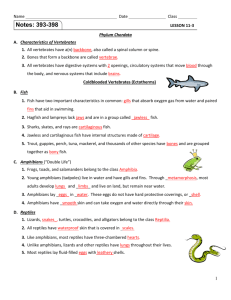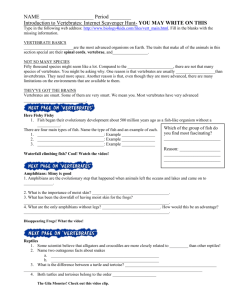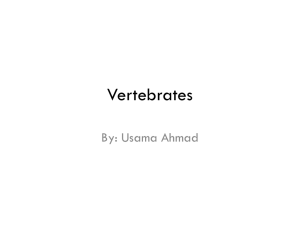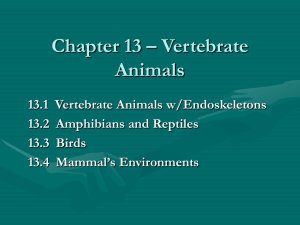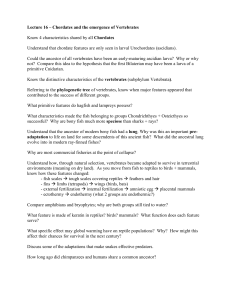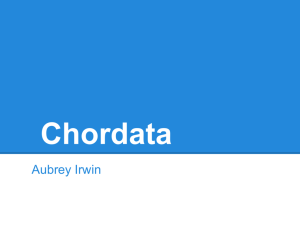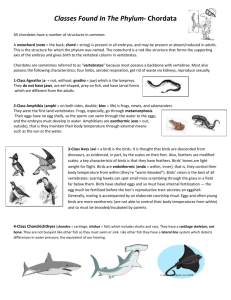What is a vertebrate?
advertisement
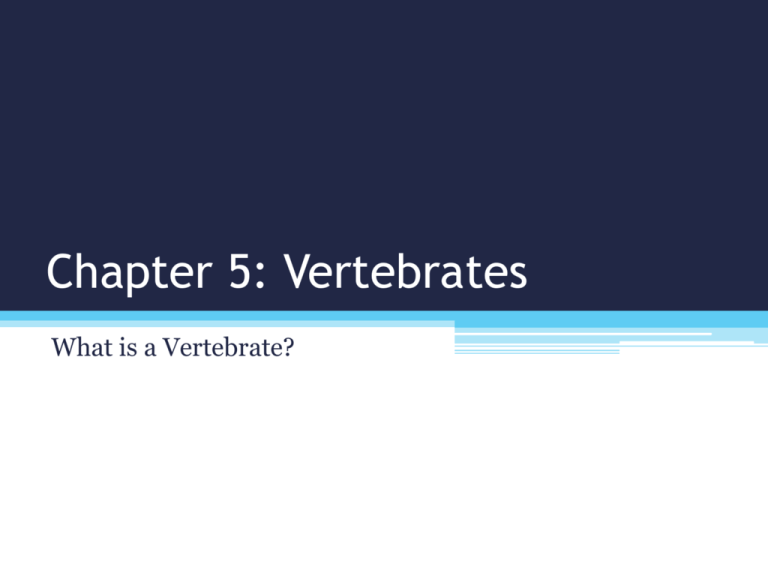
Chapter 5: Vertebrates What is a Vertebrate? What is a vertebrate? • Animals with backbones. • Only about 5% of animal species. • Endoskeleton: internal support system that grows along with the animal. • Muscles, digestive system, respiratory system, circulatory system, and nervous system. What is a vertebrate? • Named for specialized bones called vertebrae, also known as the backbone. • We will be learning about fish, amphibians, reptiles, birds, and mammals in this chapter. Chapter 5: Vertebrates Chordates Fish Most vertebrates are fish. • More than 20,000 species. • Live in nearly all aquatic environments. • They have adapted to survive many environments. Most vertebrates are fish. • Most move by using muscles and fins to push their bodies through water. • Most also have a swim bladder, which allows them to regulate how high or low they float. • Sensory organs, including eyes. • Lateral line: allows fish to sense vibrations from other objects without seeing/touching them. Fish Most vertebrates are fish. • Fish remove oxygen from water by gills. • Made of many folds of tissue and filled with blood. • Water is brought in through the mouth, pushed over the gills, and then removed through the gill slits. Jawless Fish • Most similar to the first fish on Earth. • Simpler bodies- tube-like shape and no stomach. • They have no jaw, but do have teeth that cannot chew. ▫ They get food by latching onto animals and sucking out flesh and fluids. • Lampreys and hagfish Jawless Fish Cartilaginous Fish • Sharks, rays, and skates. • Skeletons are made of cartilage, not bones. • Most eat small animals such as mollusks and crustaceans. • Rays eat by pulling animals out of the sand on the ocean floor. Cartilaginous Fish Bony Fish • Most fish (96%) are bony – tuna, flounder, eels, goldfish, etc. • Skeletons made of hard bones, usually covered by bony structures called scales. • They have jaws with teeth and several pairs of fins. Bony Fish • There are several adaptations of these fish for survival in their environments. • In the tropics, fish are brightly colored to fit in with the coral. • In other areas, bright colors would draw too much attention to the fish. Bony Fish Fish Life Cycles • Most reproduce sexually. • Female fish release eggs into the water when a suitable male is there to fertilize them. • After fertilization, the eggs are left on their own (usually) to hatch. Fish Life Cycles • Most fish eggs are surrounded by a soft egg case that allows water to move through it, giving the embryo water and oxygen. • The yolk provide nutrition to the growing embryo. • Very few eggs actually hatch into mature fish; they are usually eaten before they hatch. Chapter 5: Vertebrates Amphibians Amphibians • The first group of vertebrates to live on land. • Took millions of years for adaptations to occur allowing this group to evolve. • Frogs, toads, and salamanders Amphibians • Two pair of legs • Lay eggs in water • Obtain oxygen through moist skin; many have lungs • Sensory organs adapted for life on land. Amphibians • Their skin functions only when it is moist, so they live in moist environments. • Some are most active at night when there is more moisture near the ground, while others live mostly underground. Amphibians • Reproduce sexually. • Female lays eggs in water, male fertilizes the eggs, and then they are left to hatch on their own. • The yolk in the egg provides nutrition, and because there is no hard covering, they can get water and oxygen from surroundings. Amphibians – Life Cycle • When egg hatches, the amphibian is called a larva. • These are called tadpoles for frogs/toads, and act like small fish. ▫ Gills ▫ Eat algae ▫ Move by swimming with tails Amphibians – Life Cycle • After a few weeks, lungs begin to develop and the digestive system changes. • Develops legs, loses its tail, and its head changes shape. • Gills stop working, tongue is used to capture/eat small animals, and moves on to the land. • Some stay in or near water, others move around. • Frog Life Cycle Chapter 5: Vertebrates Frog Anatomy The Frog • Divided into a head, short neck, and trunk. • The head contains the brain, mouth, eyes, ears, and nose. The head – external • When you look at the head from the outside, you should be able to identify the following: • Eyes • Mouth • Nostrils (near mouth) • And tympanum (ear drums) located behind the eyes. The head – internal • Inside the mouth, you should see: • • • • • • Teeth Tongue Internal nostrils (nares) Esophagus opening Glottis Eustachian tube openings The head – internal • Inside the mouth, you should see: The head – internal • Inside the head, is the brain. This will be difficult to get to. The trunk – internal • • • • • • The heart The lungs The kidneys The stomach The liver The small/large intestine • The spleen • • • • • • • The pancreas The gallbladder The urinary bladder The cloaca The ureter Fat bodies And reproductive organs: ovaries/ oviducts, testes The trunk – internal The trunk – internal The trunk – internal The trunk – internal • Part 1 • Part 2 Chapter 5: Vertebrates Reptiles Reptiles • Survive in hotter, drier climates. • • • • • Two pair of legs Tough, dry skin covered by scales Get oxygen through lungs Sensory organs for land Lay their eggs, in shells, on land Lungs • Born with lungs; do not use skin to take in O2. • Takes in oxygen through mouth/nostrils and moves it into lungs; • Exhales carbon dioxide Skin • Dry and tough, covered with scales made from keratin. • Waterproof • Protects from environment and predators Eggs • Eggs contain everything an embryo needs: water, nutrients, gas exchange, waste storage. • Membranes separate the internal parts, which are covered by hard shell. • Reproduce sexually. • After fertilization, the hard covering forms around each egg while still inside the female. Eggs • The female chooses a place on land to lay the eggs. • Some guard their eggs and care for offspring once they hatch (alligators). • Most leave their eggs to hatch on their own. • Once hatched, they look like small versions of the adult. Body Temperature – Amphibians and Reptiles • Ectotherms: body temps change with the environment. • most can move/respond more quickly when warm, so they warm themselves in sun. • Many can live a long time without consuming much food. Body Temperature • Body stops functioning when too hot or too cold. • Some are able to adapt to temperature by living in certain environments. • Most live by water, which can be used to cool them down. Chapter 5: Vertebrates Birds Birds • About 10,000 species that live all around the world. • Feathers and a beak • Four limbs – pair of legs and pair of wings • Eggs have a hard shell Endotherms • Endotherm: animals that maintain a constant body temp. • Can stay active in colder climates because they have adaptations for producing more body heat from food. ▫ They need to eat a lot; birds in cooler climates need to eat more to produce more heat. Controlling Body Temp • Soft feathers (down) keep warm air close to their bodies and act as insulators. • Other feathers, contour feathers, cover their down and are usually water-resistant. • Birds shiver, like humans, to generate heat. • They can fluff their feathers to lose heat or move to shaded areas. Most can fly. • Birds first appeared about 150 million years ago, and are thought to be descendants of reptiles with adaptations to fly. • Most can fly – ostriches and penguins cannot. • Birds have many adaptations that took millions of years for them to be able to fly: Adaptations • 1. Endoskeleton: some bones are fused together without joints, making them light and strong. • 2. Wings/Feathers: flight feathers on the wings are specialized for lifting and gliding; feathers are strong to push through air. Adaptations • 3. Respiratory System: breathe using a system of air sacs and lungs; oxygen is constantly moving through the body. • 4. Hollow Bones: many of the bones are hollow with crisscrossing structures; provides strength and reduces weight. • Birds also have beaks and gizzards instead of heavier eating structures. Adaptations Benefits of Flight • Easily to see and get food. • Migration is possible in the cooler months Chapter 5: Vertebrates Mammals

